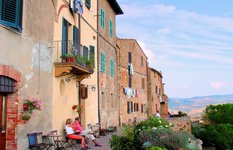 Been there
Been there
 Want to go
Want to go
 Ask friends for recommendations
Ask friends for recommendations
Things to do
- Stroll narrow cobbled streets of medieval hill towns; marvel at old churches, palaces and fortresses
- Spend a night or two on a farm, dine in a family restaurant, taste local wine
- Walk, ride a bicycle, or a horse
- Spend a night or two on a farm, dine in a family restaurant, taste local wine
- Walk, ride a bicycle, or a horse
Attractions and sights
 View Map
View Map
-
San Gimignano is a small walled medieval hill town known as the Town of Fine Towers. San Gimignano is famous for its medieval architecture, unique in the preservation of about a dozen of its tower houses, which, with its hilltop setting and encircling walls form "an unforgettable skyline". Within the walls, the well-preserved buildings include notable examples of both Romanesque and Gothic architecture, with outstanding examples of secular buildings as well as churches. The Palazzo Comunale, the Collegiate Church and Church of Sant' Agostino contain frescos, including cycles dating from the 14th and 15th centuries. The "Historic Centre of San Gimignano" is a UNESCO World Heritage Site.

-
Pienza, the "touchstone of Renaissance urbanism" is a UNESCO World Heritage Site. Main sights include the Duomo, Palazzo Piccolomini, Palazzo Vescovile and Palazzo Comunale

-
Montepulciano is a charming medieval and Renaissance hill town in southern Tuscany. It sits high on a 600 m / 2,000 ft limestone ridge. Montepulciano is renowned for its cheese, "pici" pasta, and wine. The city is renowned for its walkable, car-free nature. The main landmarks include: The Duomo, Palazzo Comunale, Palazzo Tarugi, the church of Santa Maria delle Grazie, and The Sanctuary of the Madonna di San Biagio.

-
The historic center of Siena, a UNESCO a World Heritage Site, is one of the Italy's most visited tourist attractions. Siena is famous for its cuisine, art, museums, medieval cityscape and the Palio, a traditional horse race held twice a year. Main sights include the Duomo, Piazza del Campo, Palazzo Salimbeni, and many other

-
Siena Cathedral, built mostly between 1215 and 1263, with full completion "only" by 1348. Its façade is one of the most fascinating in all of Italy and certainly one of the most impressive features in Siena. In the interior the pictorial effect of the black and white marble stripes on the walls and columns strikes the eye. The inlaid marble mosaic floor is one of the most ornate of its kind in Italy, covering the whole floor of the cathedral. The cathedral's valuable pieces of art include works by Donatello, Bernini and the young Michelangelo.

-
Piazza del Campo is the principal public space of the historic center of Siena, Tuscany, Italy and is regarded as one of Europe's greatest medieval squares. It is renowned worldwide for its beauty and architectural integrity.

-
The Palio di Siena is a horse race that is held twice each year, on July 2 and August 16, on Piazza del Campo in Siena. Ten horses and riders, bareback and dressed in the appropriate colors, represent ten of the seventeen contrade, or city wards. The race itself circles the Piazza del Campo, on which a thick layer of dirt has been laid, three times and usually lasts no more than 90 seconds. It is common for a few of the jockeys to be thrown off their horses while making the treacherous turns.

-
Orvieto is situated on the flat summit of a large butte of volcanic tuff. The site of the city is among the most dramatic in Europe, rising above the almost-vertical faces of tuff cliffs that are completed by defensive walls.

More attractions
 Hide Map
Hide Map
When to go
| |||||||||||||||||||||||||||||||||||||||||||||||||||||||||||
How to get there
By car or train, a couple of hours, from Rome, Florence or Pisa airports.
Reviews


























